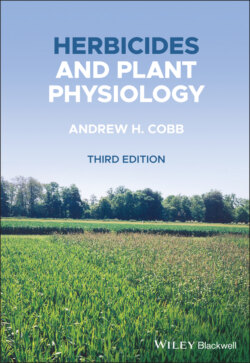Читать книгу Herbicides and Plant Physiology - Andrew H. Cobb - Страница 32
1.6 A few examples of problem weeds
ОглавлениеBlack‐grass (Alopecurus myosuroides) is of widespread distribution in Europe, temperate Asia, North America and Australia, and has become a major problem weed where winter cereals are planted and reduced cultivation methods employed. In winter cereals about 80% of black‐grass seedling emergence occurs from August to November, so crop and weed emergence coincide. The weed shows similar growth rates to the crop over the winter period, but is most aggressive from April to June with substantial grain losses being reported (Figure 1.5).
Black‐grass flowers from May to August and is cross‐pollinated. Seeds have short dormancy and viability (3% viable after 3 years), so ploughing, crop rotation or spring sowing will remove the problem.
Bracken (Pteridium aquilinum) is a widespread, poisonous perennial weed of upland pastures and is found throughout the temperate regions of the world. This fern is thought to occupy between 3500 and 7000 km2 in the UK alone, and may be spreading at 4% each year. It is difficult to control because of rhizomes that may grow up to 6 m away from the parent plant and are capable of rapid growth from underground apices and buds. The rhizome contains a starch reserve which acts as an energy reserve for the developing frond canopy. Translocated herbicides need to be repeatedly used if all rhizome buds are to be killed. Consequently, bracken is capable of rapid canopy establishment and is an aggressive coloniser of new areas. Indeed, some plants are estimated to be over 1000 years old. Other features that contribute to the success of this weed are its mycorrhizal roots, that ensure efficient nutrient uptake, especially in phosphate‐deficient soils, and a potential production of 300 million spores per plant, which can remain viable for many years if kept dry.
Figure 1.5 Effect of black‐grass density on the growth and yield of winter wheat.
Source: Moss, S.R. (1987) Competition between blackgrass (Alopecurus myosuroides) and winter wheat. British Crop Protection Conference. Weeds 2, 367–374.
Bracken creates a profound shading effect, suppressing underlying flora and gradually eliminating grass growth. Bracken also contains various carcinogens and mutagens, and is therefore poisonous to both humans and grazing animals. In addition, bracken may provide a haven for sheep ticks, which can transfer numerous sheep and grouse diseases.
Cleavers (G. aparine) is considered by many to be the most aggressive weed of winter cereals. It is of ubiquitous occurrence in hedgerows, and has become most invasive in cereals and oilseed rape. Its climbing and scrambling habit allows it to rapidly outgrow the crop to form a dense weed canopy, eventually causing severe lodging, interference with harvesting procedures, large yield losses and severe crop contamination.
There is nowadays an increasingly widespread occurrence of crop species in succeeding crops when sown in rotation. These ‘volunteer’ crops include potatoes, cereals, oilseed rape and sugar beet.
Potato ‘ground keepers’ are usually small tubers that are missed by the harvesters, although some are derived from true seeds. They can last several seasons, and pose a particular problem in subsequent pea and bean crops where they can only be eliminated by hand rogueing. They also pose a considerable threat to the health and certification of subsequent potato crops since they can carry over pests and virus infections.
Volunteer cereals can also carry foliage diseases from one season to the next and to adjacent crops, examples being yellow rust (Puccinia striiformis), brown rust (Puccinia hordei) and powdery mildew (Erysiphe graminis). These cereals may become highly competitive weeds and can smother and kill young oilseed rape seedlings, for example. Even if the seedlings survive, growth is predictably stunted and winter kill more likely. Volunteer oilseed rape plants may also create an additional problem of oil purity. Since modern varieties are grown for low erucic acid and glucosinolate content, the presence of volunteer plants could severely contaminate the crop with unacceptably high levels of these compounds, which could cause the crop to be rejected.
Weed (sugar) beet has also become a serious problem in Europe, such that at least 45% of the UK crop is infested. These bolters also severely reduce crop yield.
In all cases harvesting techniques must be improved to avoid substantial seed return to the soil, and agronomic practices should be altered to reduce rapid germination of volunteers. It is also important that volunteers containing engineered resistance to herbicides are avoided at all costs. These plants would be difficult to control by chemical means, and could have serious consequences to the spread of herbicide‐resistant genes in the population at large (Young, 1989).
The water hyacinth (Eichornia crassipes Mart. Solms) has been blamed for the loss of 10% of the water in the river Nile, equivalent to 7 × 109 m3 annually, through increased transpiration, and this loss is in addition to its deleterious effects on irrigation systems, fishing activity, navigation and health (by harbouring vectors of human disease organisms) which, together with its pan‐tropical spread, have earned it the name ‘the million dollar weed’ (Lacey, 1985).
